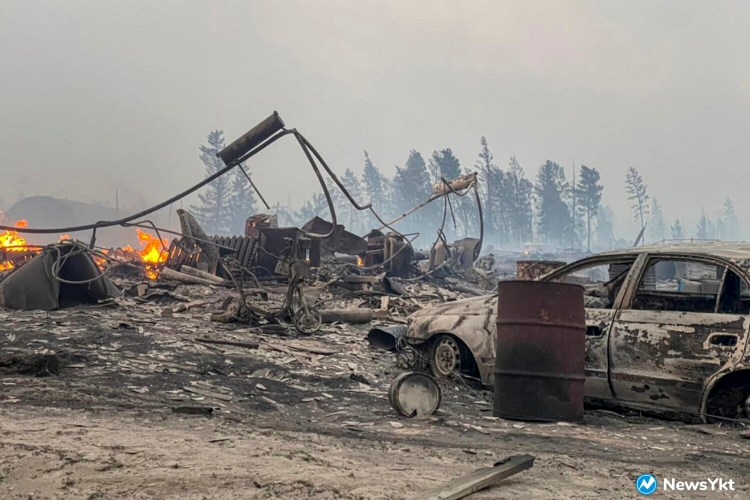For the past three months, hundreds of fires have erupted in northeast Siberia, releasing vast amounts of smoke and compromising air quality amid warmer than average temperatures. The fire season isn’t over yet but so far it’s proven extreme and probably the worst in nearly two decades.
Fires have concentrated in the Republic of Sakha, also know as Yakutia, a vast area covering nearly 1.2 million square miles in northeast Russia. Nearly twice the size of Alaska, it extends as far north as the Arctic Ocean. It is home to nearly a million people, but is sparsely populated and heavily forested. The region is known for its harsh winter climate; the temperature there in January 2018 plunged to minus-88 degrees.
Now, it is ablaze. On Tuesday, more than 100 fires covered nearly 4,000 square miles in Sakha, according to the Russian Federal Forestry Agency.
“We expect to see wildfires in the boreal forests during the summer months, but the data for 2021 does really stand out,” wrote Mark Parrington, a senior scientist with the Copernicus Atmosphere Monitoring Service, which tracks wildfire emissions via satellite observations back to 2003.
Parrington indicated the fires emitted a record-breaking amount of carbon – 108 megatons – for June 1 to Aug. 1. That is about a third more than the emissions from June 1 to Aug. 1, 2020, another particularly active fire season in Siberia; 78 megatons of carbon were released during that period.
Activity hasn’t slowed down since then. From Aug. 1 to Aug. 8, the fires emitted another whopping 80 megatons of carbon.
Smoke from the fires is clogging skies and degrading air quality locally. In July, the Siberian city of Yakutsk experienced one of the worst air pollution events worldwide, according to The Guardian.
Satellite data also showed the smoke traveled more than 2,000 miles away to reach the North Pole. While it is not unprecedented for wildfire smoke from far east Russia to extend that far north, Parrington says it is unusual to see such high concentrations of aerosols, or noxious particles emitted by the blazes, traveling such long distances. Computer models have shown some of the smoke plumes landing as far away as Canada.
“It’s really nasty burning,” said Amber Soja, an associate research fellow with the National Institute of Aerospace and resident at the NASA Langley Research Center. “In these regions, this is really thick and nasty stuff and incredibly unhealthy because it’s not fully combusted material.”
The Sakha region is covered in permafrost, or frozen soil, that is composed of soil organic matter rich in carbon. Soja explains the organic matter is hundreds to millennia old and consists of partially decomposed vegetation. Each year, trees and plants shed leaves, needles and other materials, and compact on one another year after year. Large quantities of carbon are buried deep into the permafrost and can be released through fires or from other sources of melting.
“It’s not [how] big the area, but it is how deep it’s burning down,” said Soja. “It continues to burn a massive amount of carbon that is exchanged with the atmosphere that has strong potential feedbacks to regional and global climate.”
In addition to emitting carbon dioxide, the fires can also dig up an even more potent greenhouse gas – methane. Methane can trap heat in the atmosphere about 20 times more efficiently than carbon dioxide.
Some smoke aerosols can also change the amount of incoming sunlight reaching the ground regionally. Dark-colored aerosols, such as black carbon in soot, can absorb incoming radiation and warm the surrounding atmosphere. This localized atmospheric warming can also cause cloud droplets to evaporate and can suppress precipitation nearby, potentially exacerbating fire weather in the area.
Soja explains that black carbon can also fall and land back on the permafrost. The black carbon can then absorb sunlight and melt the snow and ice, releasing more carbon reserves from the soil and into the atmosphere.
“A little bit of the permafrost melts every year down to an active layer, and that’s normal,” said Soja. “Continued burning will result in a deeper thaw and longer-term damage to the soil, flora and fauna.”
Soja said climate models have projected earlier fire seasons and deeper burns in the region as global temperatures rise. This year, fires began burning in late April. The largest clusters in Sakha in the Arctic Circle began burning in early May.
The latest Intergovernmental Panel on Climate Change report also projected an increase in extreme weather events under warmer global scenarios. They stated the Siberian heat wave in 2018, which led to widespread fires, was “extremely unlikely to occur without human influence on the climate system.”
“Climate change is not something in the distant future,” said Soja. “It is here now in the boreal forest and in the Arctic.”
Comments are not available on this story.
Send questions/comments to the editors.


